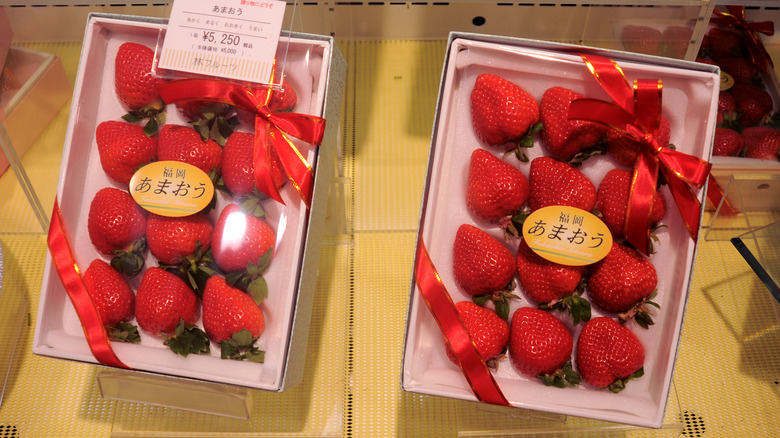Why Fruit Is Considered A Luxury In Japan
Square watermelons, golf ball-sized Muscat grapes, and white strawberries are just some of the beautiful fruits cultivated in Japan. These enticing foods are fascinating thanks to their unique shape and near-perfect appearance, but also because of their hefty price tags. A Densuke watermelon, for instance, typically costs $250, while two Hokkaido cantaloupes sold at a record-breaking price of $27,240 back in 2016. On the lower end of the spectrum, Muscat grapes generally retail for around $15+ per pound, depending on the season and quality. But how does a piece of fruit sell for a few dollars in the United States and thousands in Japan? One of the main reasons is because of the country's harsh agricultural system.
Most of the land where it is possible to farm is used to grow rice. With only a small amount left over to grow other crops, very little is used for fruit. On top of this, all farmland must be operated by the land owner. This means that farms are kept significantly smaller to make them more manageable, resulting in slower, less efficient production. Fruit is typically given extra attention and care because the country values super flavorful fruit that is blemish-free. For example, farmers will use labor-intensive practices such as growing just one melon per vine to ensure it is of the highest possible quality, alongside even massaging the melon daily to bring out extra sweetness.
Fruit is frequently given as a gift in Japan
In many other countries fruit is eaten with breakfast or as a snack; in Japan, it is given as a gift and sometimes eaten as a dessert. Due to its higher price tag, fruit is considered much more of a luxury item, making it a generous and thoughtful present. Fruit is perishable and, obviously, edible so it's great as a gift because it does not remain in the home as clutter. It's meant to be enjoyed in the moment, and serve as a reminder of the passing seasons, which is a big deal in Japan.
If you visit Japan, you'll notice that fruit is not a common occurrence on menus, except when it's incorporated into ice creams or served in the iconic Japanese fruit sandwich. However, outside of restaurants and gift-giving, it's still possible to find fruit in Japan for everyday consumption that doesn't break the bank.
While fruit is still pricier than in other countries, any that's in season in Japan tends to be more affordable. Shopping for fruit in the countryside where it's grown will be cheaper since it hasn't been transported anywhere. The affordable, average-grade fruit can also be found in convenience stores or supermarkets.

